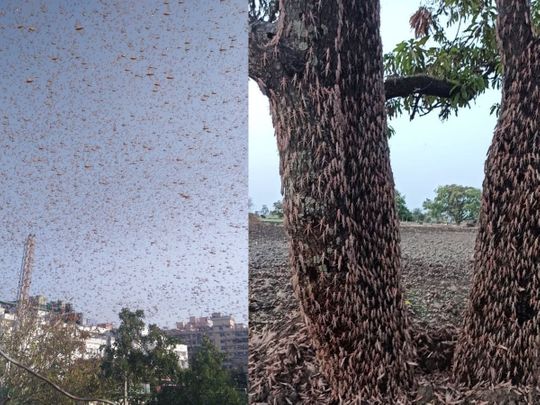
Massive swarms of desert locusts are invading western and central India, destroying crops. The nation’s worst locust attack in nearly three decades is now spreading to Maharashtra, Uttar Pradesh and Punjab now, after Rajasthan, Gujarat, Madhya Pradesh and Haryana. Many Indians have taken to social media to share videos and photos of swarms of locusts blanketing entire towns, as India gets ready to end its COVID-19 lockdown.
Facebook user Arudhra Shetty posted: “As if India needed any more problems right now, first the increase in coronavirus cases, the lockdown that resulted in a migrant crisis and unemployment, then a cyclone, now the heatwave and new problem – a locust invasion.”
Reportedly, official sources say that this is the worst locust infestation that India has seen in 26 years. But, that’s not all, these locusts are different.
“This time the attack is by very young locusts who fly for longer distances, at faster speeds, unlike adults in the past who were sluggish and not so fast,” according to KL Gurjar, the deputy director of India’s Locust Warning Organization.
A Suratgarh official said: “New swarms are continuing to come from across the border. This time, they are much greater in number."
Crop damage and food crisis
Locust swarms devastate crops and cause major agricultural damage and related human misery—famine and starvation.
According to the UN physique Food and Agriculture Organisation (FAO), the locusts assault pose a menace to meals safety of the affected international locations as an grownup locust can eat an amount equal to its weight of about two grams each single day.
A single square kilometre of the swarm can comprise someplace between four to eight crore grownup locusts. Every single day, in the event that they cover 130-150 km, they will eat the meals consumed by as many as 35,000 individuals, it stated. Large swarms of locusts can completely strip the foliage and stems of plants.
The desert locust is the most dangerous of the nearly one dozen species of locusts, which have wreaked havoc in several countries in Africa and West Asia as well as in Pakistan, devouring standing crops and vegetables. The insects pose a serious threat to farmers, especially when India is gearing up for the sowing of kharif crops. These are monsoon crops or autumn crops, including domesticated plants, like rice that are cultivated and harvested in India during the subcontinent's monsoon season, which lasts from June to November.
Many Tweeps took to Twitter to highlight how this was affecting the farmers of the country, who were already facing trouble. Tweep @GirishK18868118 posted: “These locust menace are posing a great threat to the farmer community. The state governments of affected area must come together and solve this problem.”
And, @BrianNunes9 tweeted: “I pity our farmers of our country right from tackling money lenders, unseasonal rains, pandemic and now locusts damaging their farms. Almighty, I pray to you of saving them from more damages.”
And, @sohail_shafaq tweeted: “As you read this thread, the super swarm has reached Maharashtra. This is the region with most farmer suicides in India. What happens next is easy to guess.”
In Maharashtra, swarms of locusts that had entered Katol and Parseoni in Nagpur district during the last four days would possibly transfer in direction of Ramtek although “it’s tough to foretell their precise flying course”, a senior agriculture division official stated.
And, after attacking crops in Madhya Pradesh, a swarm of locusts reached Uttar Pradesh’s Jhansi district on Wednesday, an authorities official stated. Other districts within the area are additionally on alert.
Reportedly, the pest, which threatens vegetable and pulse crops, haven’t impacted rabi (winter) produce in India, however the authorities are trying to eradicate the bugs before monsoon in an effort to save kharif crops, officers from the Locust Warning Organisation (LWO) stated on Wednesday.
Blasting mudic to banging steel plates: How farmers are fighting the locust attack
Locusts tend to move to quiet areas and stay away from sources of high decibel sounds. It’s common for farmers to use loud noises to keep locusts away.
The farmers in UP have devised a unique method to tackle the problem. In a video tweeted by UP cop in Jhansi, Rahul Shrivastava, a vehicle fitted with DJ system can be seen blasting music to minimise the potential damage of the crop-hungry locusts.
He tweeted: "DJ isn't just for dancing and parties but is also effective in warding off locusts. Everyone sees a new morning, you can make noise or bang utensils to do them away."
From banging utensils to using police sirens, people are trying all desperate measures to scare the locusts away.
Not just farms
However, it is not just agricultural farms that are affected, swarms of locusts even took over urban areas, and have covered trees and grass patches in golf courses.
Here are some videos shared by Twitter users:
Locust swarms can cover 50-100km a day
Locusts belong to the grasshoppers family. Environmental situations like monsoon and heavy cyclones make them reproduce sooner. The swarm is very mobile and covers 50 to greater than 100 km in a day.
Scientists say that this outbreak, similar to recent outbreaks in East Africa, is driven by the same factors: unusually warm weather and more rain. They blame climate change.
Experts fear that the locust swarms could swell by June, if more action is not taken urgently to control their infestation and mitigate damage.
Ajayvir Jakhar, chairman of Bharat Krishak Samaj, a farmers’ advocacy group has reportedly said: “The problem is clearly going to continue for the next four months at least, and the government is capable of handling it. There may not be a food security crisis, but there is likelihood of livelihood crisis on those farms which would be invaded by locusts. So, the government should not only use its resources to stop this menace from spreading, but also make provisions to compensate farmers whose farms are damaged by these pests."
Containment efforts
The federal government have said that they have stepped up the response. Reportedly, locust containment measures and sprinkling operations have been performed in 303 places unfold over greater than 47,000 hectares until Wednesday in 20 districts of Rajasthan, nine in Madhya Pradesh, two in Gujarat and one every in Uttar Pradesh and Punjab, according to India’s Agriculture Ministry.
Reportedly, the authorities are using specialised spraying machines. Agriculture Minister Narendra Singh Tomar is intently monitoring the state of affairs and held three conferences with state agriculture ministers and representatives of pesticides corporations, officers stated. The authorities can be inviting tenders for drones for aerial spraying of pesticides.








